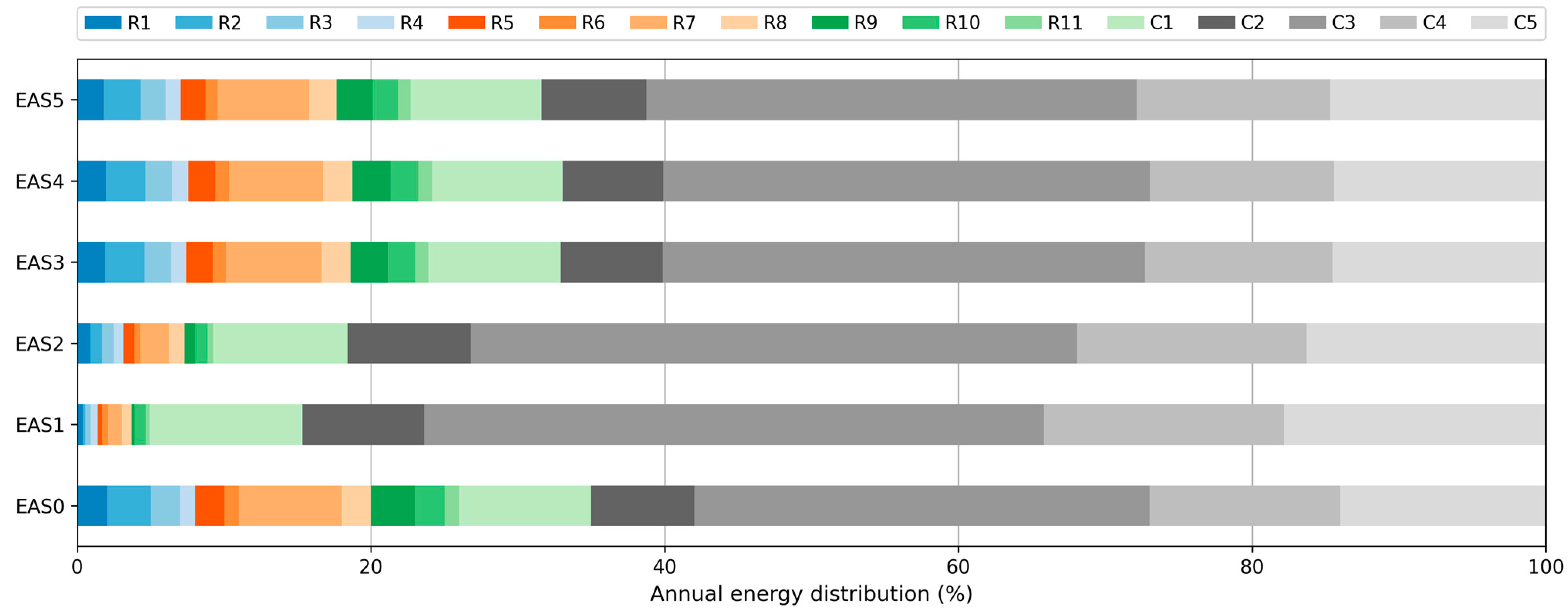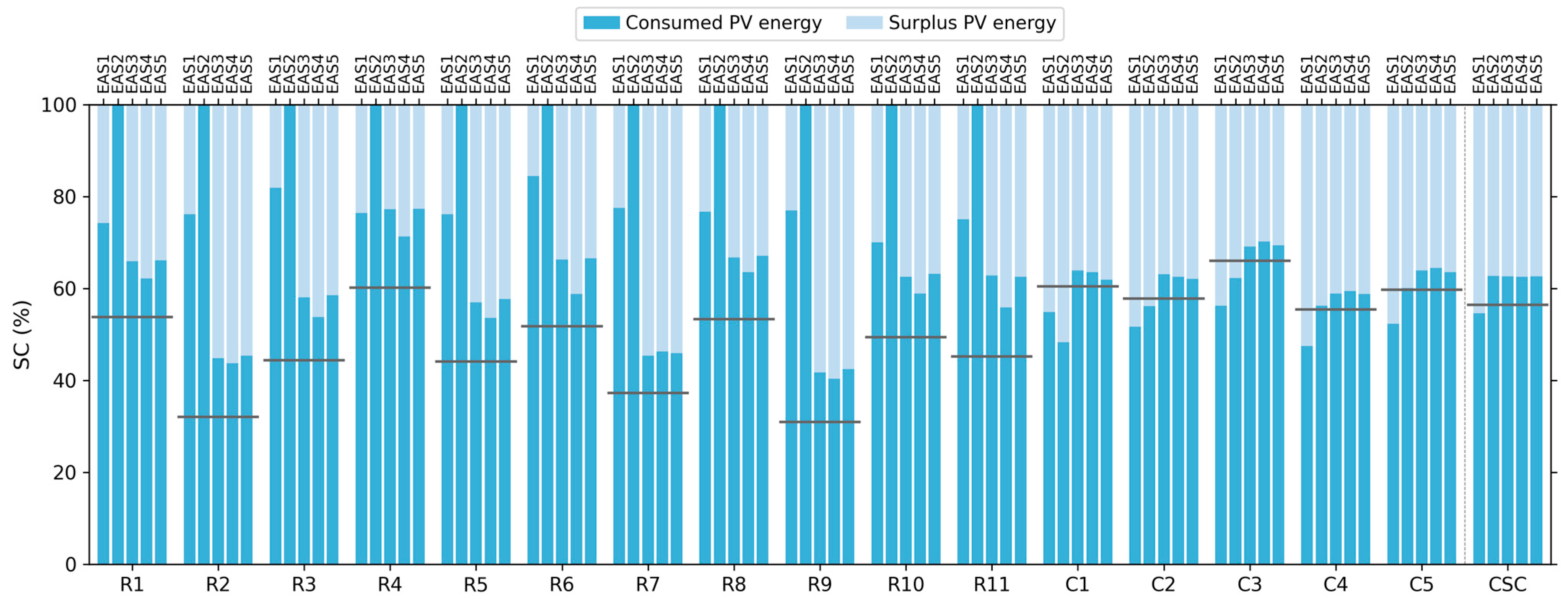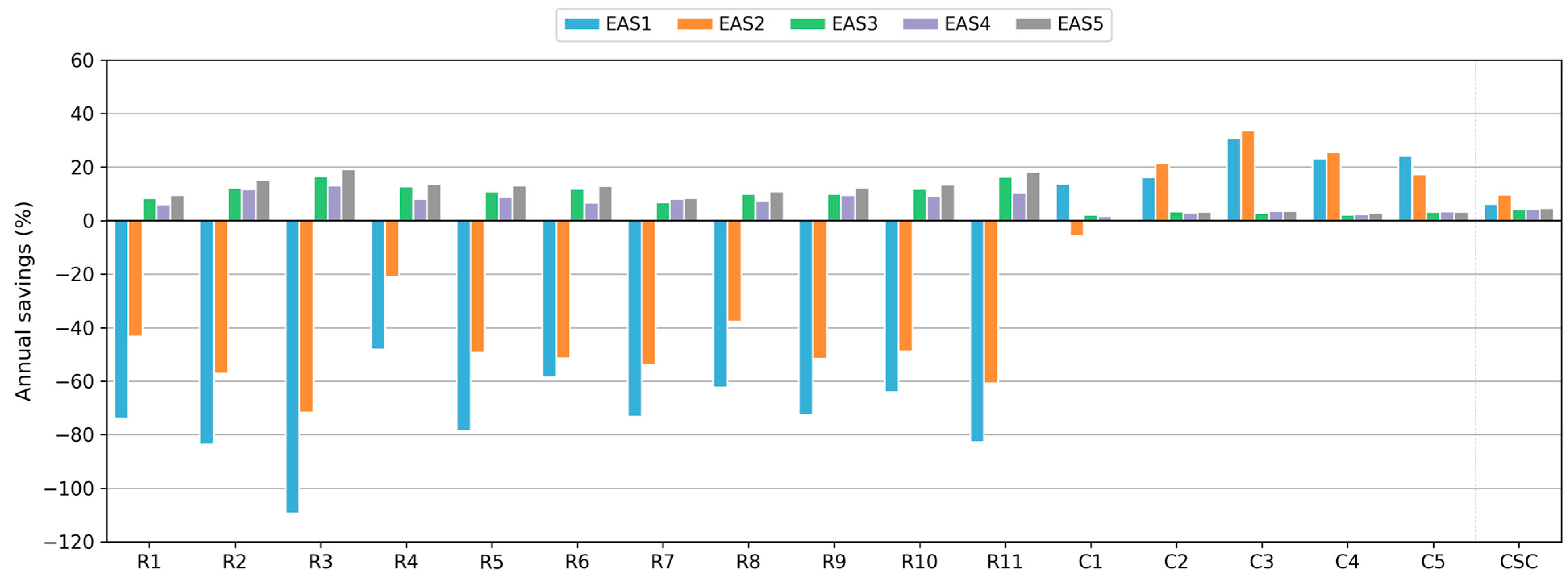Optimization of Energy Allocation Strategies in Spanish Collective Self-Consumption Photovoltaic Systems
Abstract
:1. Introduction
2. Materials and Methods
3. Case Study
4. Results and Discussion
4.1. Economic Profitability
4.2. Energy Distribution
4.3. Self-Consumption
4.4. Self-Sufficiency
4.5. Internal Energy Exchanges
4.6. Sensitivity Analysis
4.6.1. Cases 1 and 2
4.6.2. Case 3
4.6.3. Case 4
5. Conclusions
Author Contributions
Funding
Institutional Review Board Statement
Informed Consent Statement
Data Availability Statement
Conflicts of Interest
References
- European Commission; Directorate-General for Climate Action. Going Climate-Neutral by 2050: A Strategic Long-Term Vision for a Prosperous, Modern, Competitive and Climate-Neutral EU Economy; Publications Office: Luxembourg, 2019. [Google Scholar]
- European Commission. Communication from the Commission to the European Parliament, the European Council, the Council, the European Economic and Social Committee and the Committee of the Regions. REPowerEU Plan; European Commission: Luxembourg, 2018. [Google Scholar]
- European Commission; Directorate-General for Energy. Clean Energy for All Europeans; Publications Office: Luxembourg, 2019. [Google Scholar]
- Cejka, S. Legal Measures to Aid Profitability for Energy Communities and Their Participants. In Proceedings of the 2020 Zooming Innovation in Consumer Technologies Conference, Novi Sad, Serbia, 26–27 May 2020; pp. 248–250. [Google Scholar] [CrossRef]
- European Union. Directive (EU) 2018/2001 of the European Parliament and of the Council of 11 December 2018 on the Promotion of the Use of Energy from Renewable Sources; European Union: Luxembourg, 2018; Volume 5. [Google Scholar]
- European Union. Directive (EU) 2019/944 of the European Parliament and of the Council of 5 June 2019 on Common Rules for the Internal Market for Electricity and Amending Directive 2012/27/EU (Text with EEA Relevance); European Union: Luxembourg, 2019; Volume PE/10/2019/REV/1. [Google Scholar]
- European Commission. Communication from the Commission to the European Parliament, the European Council, the Council, the European Economic and Social Committee and the Committee of the Regions. EU Solar Energy Strategy; European Commission: Luxembourg, 2022. [Google Scholar]
- Luthander, R.; Widén, J.; Nilsson, D.; Palm, J. Photovoltaic Self-Consumption in Buildings: A Review. Appl. Energy 2015, 142, 80–94. [Google Scholar] [CrossRef] [Green Version]
- Roberts, M.B.; Bruce, A.; MacGill, I. Impact of Shared Battery Energy Storage Systems on Photovoltaic Self-Consumption and Electricity Bills in Apartment Buildings. Appl. Energy 2019, 245, 78–95. [Google Scholar] [CrossRef]
- Schiera, D.S.; Minuto, F.D.; Bottaccioli, L.; Borchiellini, R.; Lanzini, A. Analysis of Rooftop Photovoltaics Diffusion in Energy Community Buildings by a Novel GIS- and Agent-Based Modeling Co-Simulation Platform. IEEE Access 2019, 7, 93404–93432. [Google Scholar] [CrossRef]
- Radl, J.; Fleischhacker, A.; Revheim, F.H.; Lettner, G.; Auer, H. Comparison of Profitability of PV Electricity Sharing in Renewable Energy Communities in Selected European Countries. Energies 2020, 13, 5007. [Google Scholar] [CrossRef]
- Syed, M.M.; Hansen, P.; Morrison, G.M. Performance of a Shared Solar and Battery Storage System in an Australian Apartment Building. Energy Build. 2020, 225, 110321. [Google Scholar] [CrossRef]
- Korjani, S.; Facchini, A.; Mureddu, M.; Rubino, A.; Damiano, A. Battery Management for Energy Communities—Economic Evaluation of an Artificial Intelligence-Led System. J. Clean. Prod. 2021, 314, 128017. [Google Scholar] [CrossRef]
- Cheng, L.; Bae, Y.; Horton, W.T. A System-Level Approach for Designing Multi-Family Sustainable and Energy-Efficient Housing Communities. Sustain. Cities Soc. 2019, 44, 183–194. [Google Scholar] [CrossRef]
- Karunathilake, H.; Hewage, K.; Mérida, W.; Sadiq, R. Renewable Energy Selection for Net-Zero Energy Communities: Life Cycle Based Decision Making under Uncertainty. Renew. Energy 2019, 130, 558–573. [Google Scholar] [CrossRef]
- Roberts, M.B.; Sharma, A.; MacGill, I. Efficient, Effective and Fair Allocation of Costs and Benefits in Residential Energy Communities Deploying Shared Photovoltaics. Appl. Energy 2022, 305, 117935. [Google Scholar] [CrossRef]
- Ministerio para la Transición Ecológica y el Reto Demográfico. Resolución de 25 de Marzo de 2021, Conjunta de La Dirección General de Política Energética y Minas y de La Oficina Española de Cambio Climático, Por La Que Se Publica El Acuerdo Del Consejo de Ministros de 16 de Marzo de 2021, Por El Que Se Adopta La Versión Final Del Plan Nacional Integrado de Energía y Clima 2021–2030; Boletín Oficial del Estado: Madrid, Spain, 2021.
- Ministerio para la Transición Ecológica y el Reto Demográfico. Hoja de Ruta Del Autoconsumo; Ministerio Para la Transición Ecológica y el Reto Demográfico: Madrid, Spain, 2021.
- Inês, C.; Guilherme, P.L.; Esther, M.G.; Swantje, G.; Stephen, H.; Lars, H. Regulatory Challenges and Opportunities for Collective Renewable Energy Prosumers in the EU. Energy Policy 2020, 138, 111212. [Google Scholar] [CrossRef]
- Jefatura del Estado. Real Decreto-Ley 15/2018, de 5 de Octubre, de Medidas Urgentes Para La Transición Energética y La Protección de Los Consumidores; Boletín Oficial del Estado: Madrid, Spain, 2018; Volume 242.
- Ministerio para la Transición Ecológica. Real Decreto 244/2019, de 5 de Abril, Por El Que Se Regulan Las Condiciones Administrativas, Técnicas y Económicas Del Autoconsumo de Energía Eléctrica; Boletín Oficial del Estado: Madrid, Spain, 2019; Volume 83.
- Ministerio para la Transición Ecológica y el Reto Demográfico. Orden TED/371/2021, de 19 de Abril, Por La Que Se Establecen Los Precios de Los Cargos Del Sistema Eléctrico y de Los Pagos Por Capacidad Que Resultan de Aplicación a Partir Del 1 de Junio de 2021; Boletín Oficial del Estado: Madrid, Spain, 2021.
- Jefatura del Estado. Real Decreto-Ley 18/2022, de 18 de Octubre, Por El Que Se Aprueban Medidas de Refuerzo de La Protección de Los Consumidores de Energía y de Contribución a La Reducción Del Consumo de Gas Natural En Aplicación Del “Plan + Seguridad Para Tu Energía (+SE)”, Así Como Medidas En Materia de Retribuciones Del Personal al Servicio Del Sector Público y de Protección de Las Personas Trabajadoras Agrarias Eventuales Afectadas Por La Sequía; Boletín Oficial del Estado: Madrid, Spain, 2022.
- Jefatura de Estado. Real Decreto-Ley 20/2022, de 27 de Diciembre, de Medidas de Respuesta a Las Consecuencias Económicas y Sociales de La Guerra de Ucrania y de Apoyo a La Reconstrucción de La Isla de La Palma y a Otras Situaciones de Vulnerabilidad; Boletín Oficial del Estado: Madrid, Spain, 2022.
- Wang, J.; Garifi, K.; Baker, K.; Zuo, W.; Zhang, Y.; Huang, S.; Vrabie, D. Optimal Renewable Resource Allocation and Load Scheduling of Resilient Communities. Energies 2020, 13, 5683. [Google Scholar] [CrossRef]
- De Villena, M.M.; Aittahar, S.; Mathieu, S.; Boukas, I.; Vermeulen, E.; Ernst, D.; Manuel De Villena, M. Allocation of Locally Generated Electricity in Renewable Energy Communities. arXiv 2020, arXiv:2009.05411. [Google Scholar]
- Reis, I.F.G.; Gonçalves, I.; Lopes, M.A.R.; Antunes, C.H. Collective Self-Consumption in Multi-Tenancy Buildings–To What Extent Do Consumers’ Goals Influence the Energy System’s Performance? Sustain. Cities Soc. 2022, 80, 103688. [Google Scholar] [CrossRef]
- Ye, G.; Li, G.; Wu, D.; Chen, X.; Zhou, Y. Towards Cost Minimization with Renewable Energy Sharing in Cooperative Residential Communities. IEEE Access 2017, 5, 11688–11699. [Google Scholar] [CrossRef]
- Fina, B.; Monsberger, C.; Auer, H. Simulation or Estimation?—Two Approaches to Calculate Financial Benefits of Energy Communities. J. Clean. Prod. 2022, 330, 129733. [Google Scholar] [CrossRef]
- Manso-Burgos, Á.; Ribó-Pérez, D.; Alcázar-Ortega, M.; Gómez-Navarro, T. Local Energy Communities in Spain: Economic Implications of the New Tariff and Variable Coefficients. Sustainability 2021, 13, 10555. [Google Scholar] [CrossRef]
- Plaza, C.; Gil, J.; De Chezelles, F.; Strang, K.A. Distributed Solar Self-Consumption and Blockchain Solar Energy Exchanges on the Public Grid within an Energy Community. In Proceedings of the 2018 IEEE International Conference on Environment and Electrical Engineering and 2018 IEEE Industrial and Commercial Power Systems Europe, EEEIC/I and CPS Europe 2018, Palermo, Italy, 12–15 June 2018. [Google Scholar] [CrossRef]
- Pedrero, J.; Hernández, P.; Martínez, Á. Economic Evaluation of PV Installations for Self-Consumption in Industrial Parks. Energies 2021, 14, 728. [Google Scholar] [CrossRef]
- Rocha, R.; Mello, J.; Villar, J.; Saraiva, J.T. Comparative Analysis of Self-Consumption and Energy Communities Regulation in the Iberian Peninsula. In Proceedings of the 2021 IEEE Madrid PowerTech, PowerTech 2021, Madrid, Spain, 28 June–2 July 2021. [Google Scholar] [CrossRef]
- Comisión Nacional de los Mercados y la Competencia. Circular 3/2020, de 15 de Enero, de La Comisión Nacional de Los Mercados y La Competencia, Por La Que Se Establece La Metodología Para El Cálculo de Los Peajes de Transporte y Distribución de Electricidad; Boletín Oficial del Estado: Madrid, Spain, 2020. [Google Scholar]












| EAS | Coefficients | Method | Internal Exchange |
|---|---|---|---|
| EAS0 | Static | Allocation rules (ownership) | No |
| EAS1 | Static (changing every 4 months) | Optimization (minimizing total cost) | No |
| EAS2 | Variable | Optimization (minimizing total cost) | No |
| EAS3 | Variable | Allocation rules (equal distribution) | Yes |
| EAS4 | Variable | Allocation rules (proportional distribution) | Yes |
| EAS5 | Variable | Allocation rules (maximum profit) | Yes |
| Type of User | User | Annual Consumption (kWh) | CSC System Property | Annual Photovoltaic Generation (kWh) |
|---|---|---|---|---|
| Residential | R1 | 4231 | 2% | 2239 |
| R2 | 5796 | 3% | 3158 | |
| R3 | 3497 | 2% | 2139 | |
| R4 | 2004 | 1% | 1252 | |
| R5 | 3890 | 2% | 2108 | |
| R6 | 1812 | 1% | 1043 | |
| R7 | 13,984 | 7% | 7811 | |
| R8 | 3888 | 2% | 2333 | |
| R9 | 6130 | 3% | 3057 | |
| R10 | 3477 | 2% | 2202 | |
| R11 | 1749 | 1% | 1041 | |
| Commercial | C1 | 17,805 | 9% | 11,142 |
| C2 | 13,974 | 7% | 8934 | |
| C3 | 64,165 | 31% | 41,787 | |
| C4 | 25,229 | 13% | 16,463 | |
| C5 | 27,577 | 14% | 18,386 |
| User | Tariff | Electricity Price per Period (EUR/kWh) | Surplus Energy Price (EUR/kWh) | |||||
|---|---|---|---|---|---|---|---|---|
| P1 | P2 | P3 | P4 | P5 | P6 | |||
| R1 | 2.0TD | 0.167797 | 0.167797 | 0.167797 | - | - | - | 0.10 |
| R2 | 2.0TD | 0.163500 | 0.163500 | 0.163500 | - | - | - | 0.10 |
| R3 | 2.0TD | 0.220500 | 0.167700 | 0.127800 | - | - | - | 0.10 |
| R4 | 2.0TD | 0.189999 | 0.189999 | 0.189999 | - | - | - | 0.10 |
| R5 | 2.0TD | 0.173600 | 0.173600 | 0.173600 | - | - | - | 0.10 |
| R6 | 2.0TD | 0.195300 | 0.195300 | 0.195300 | - | - | - | 0.10 |
| R7 | 2.0TD | 0.209357 | 0.172764 | 0.161018 | - | - | - | 0.10 |
| R8 | 2.0TD | 0.239999 | 0.189999 | 0.169999 | - | - | - | 0.10 |
| R9 | 2.0TD | 0.169935 | 0.169935 | 0.169935 | - | - | - | 0.10 |
| R10 | 2.0TD | 0.199000 | 0.199000 | 0.199000 | - | - | - | 0.10 |
| R11 | 2.0TD | 0.226880 | 0.174232 | 0.152188 | - | - | - | 0.10 |
| C1 | 3.0TD | 0.303784 | 0.309006 | 0.241286 | 0.231910 | 0.235275 | 0.227407 | 0.15 |
| C2 | 3.0TD | 0.325721 | 0.298538 | 0.273652 | 0.244706 | 0.227830 | 0.234187 | 0.15 |
| C3 | 3.0TD | 0.318910 | 0.324940 | 0.249155 | 0.240498 | 0.254178 | 0.237339 | 0.15 |
| C4 | 3.0TD | 0.342000 | 0.312000 | 0.279000 | 0.256000 | 0.234000 | 0.224000 | 0.15 |
| C5 | 3.0TD | 0.310301 | 0.292479 | 0.266464 | 0.280949 | 0.251109 | 0.251909 | 0.15 |
| Annual Savings (%) | |||||||||||||||||
|---|---|---|---|---|---|---|---|---|---|---|---|---|---|---|---|---|---|
| R1 | R2 | R3 | R4 | R5 | R6 | R7 | R8 | R9 | R10 | R11 | C1 | C2 | C3 | C4 | C5 | CSC | |
| EAS1 | −73.9 | −83.8 | −109.4 | −48.2 | −78.7 | −58.6 | −73.3 | −62.4 | −72.6 | −64.0 | −82.8 | 13.7 | 16.2 | 30.6 | 23.3 | 24.1 | 6.3 |
| EAS2 | −43.4 | −57.3 | −71.7 | −21.0 | −49.4 | −51.4 | −53.9 | −37.7 | −51.6 | −48.8 | −60.8 | −5.8 | 21.4 | 33.7 | 25.5 | 17.3 | 9.6 |
| EAS3 | 8.4 | 12.1 | 16.4 | 12.8 | 10.8 | 11.8 | 6.9 | 9.9 | 9.9 | 11.7 | 16.3 | 2.2 | 3.3 | 2.8 | 2.1 | 3.2 | 4.1 |
| EAS4 | 6.0 | 11.6 | 13.1 | 8.1 | 8.7 | 6.6 | 8.0 | 7.4 | 9.6 | 9.0 | 10.2 | 1.7 | 2.9 | 3.5 | 2.3 | 3.4 | 4.1 |
| EAS5 | 9.5 | 15.1 | 19.1 | 13.5 | 13.0 | 13.0 | 8.5 | 10.9 | 12.3 | 13.4 | 18.2 | 0.7 | 3.3 | 3.6 | 2.8 | 3.3 | 4.7 |
| Case | Description |
|---|---|
| Case 1 | Prices +20%, both purchase and surplus |
| Case 2 | Prices −20%, both purchase and surplus |
| Case 3 | Same price of purchasing and selling for all users |
| Case 4 | Different ownership coefficients |
Disclaimer/Publisher’s Note: The statements, opinions and data contained in all publications are solely those of the individual author(s) and contributor(s) and not of MDPI and/or the editor(s). MDPI and/or the editor(s) disclaim responsibility for any injury to people or property resulting from any ideas, methods, instructions or products referred to in the content. |
© 2023 by the authors. Licensee MDPI, Basel, Switzerland. This article is an open access article distributed under the terms and conditions of the Creative Commons Attribution (CC BY) license (https://creativecommons.org/licenses/by/4.0/).
Share and Cite
Ogando-Martínez, A.; García-Santiago, X.; Díaz García, S.; Echevarría Camarero, F.; Blázquez Gil, G.; Carrasco Ortega, P. Optimization of Energy Allocation Strategies in Spanish Collective Self-Consumption Photovoltaic Systems. Sustainability 2023, 15, 9244. https://doi.org/10.3390/su15129244
Ogando-Martínez A, García-Santiago X, Díaz García S, Echevarría Camarero F, Blázquez Gil G, Carrasco Ortega P. Optimization of Energy Allocation Strategies in Spanish Collective Self-Consumption Photovoltaic Systems. Sustainability. 2023; 15(12):9244. https://doi.org/10.3390/su15129244
Chicago/Turabian StyleOgando-Martínez, Ana, Xela García-Santiago, Saúl Díaz García, Fernando Echevarría Camarero, Gonzalo Blázquez Gil, and Pablo Carrasco Ortega. 2023. "Optimization of Energy Allocation Strategies in Spanish Collective Self-Consumption Photovoltaic Systems" Sustainability 15, no. 12: 9244. https://doi.org/10.3390/su15129244






